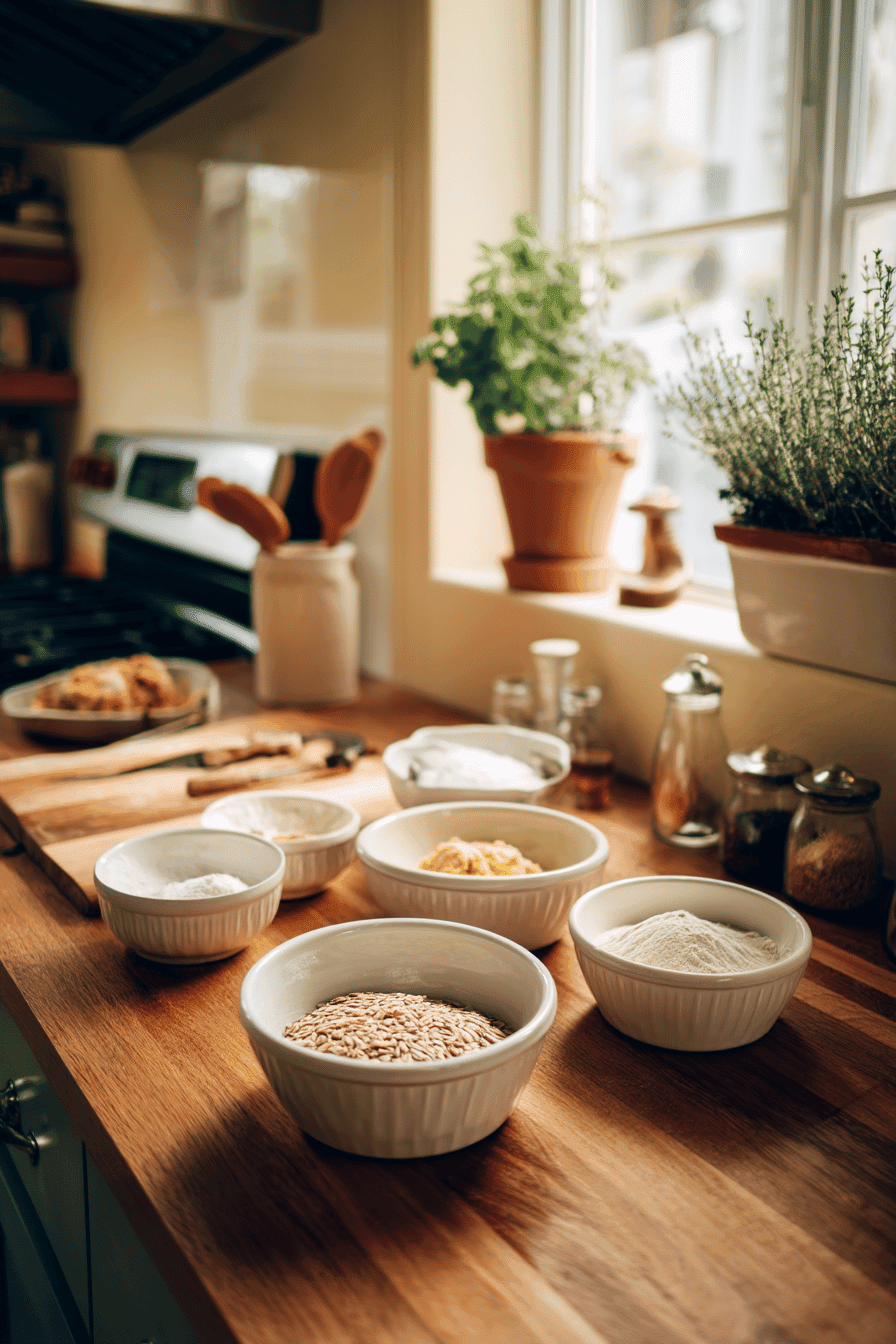Benefits and Advantages of Lemon Cake
This lemon cake recipe is especially effective due to its ease of preparation, allowing even novice bakers to create a moist, flavorful dessert with minimal effort. The use of fresh lemon juice and zest not only provides a bright, tangy flavor but also adds a natural source of vitamin C, contributing to the cake’s health benefits. Additionally, the recipe balances sweetness and acidity perfectly, resulting in a refreshing treat that feels lighter than many traditional desserts.
This lemon cake is versatile, with ingredients easily adjusted to fit specific dietary needs without compromising taste or texture. The natural lemon components deliver a fresh and vibrant flavor that artificial alternatives rarely achieve. This combination of simplicity, flavor, and adaptability makes lemon cake a popular choice for many occasions.
Jump to:
- Benefits and Advantages of Lemon Cake
- Essential Ingredients for Lemon Cake
- Dietary Substitutions to Customize Your Lemon Cake
- How to Prepare the Perfect Lemon Cake: Step-by-Step Guide
- Mastering Lemon Cake: Advanced Tips and Variations
- How to Store Lemon Cake: Best Practices
- Nutritional Value of Lemon Cake
- FAQs: Frequently Asked Questions About Lemon Cake
- Can I bake lemon cake in a muffin tin instead of a cake pan?
- What type of flour works best for lemon cake to get a fluffy texture?
- How should I store lemon cake to keep it fresh, especially with cream cheese frosting?
- Can I customize the lemon flavor if I don’t have lemon extract or essence?
- Is it possible to make a multi-layer lemon cake using this recipe for special occasions?
- Moist and Soft Lemon Layer Cake with Cream Cheese Frosting Recipe
- Ingredients
- Instructions
- Last Step:
- Notes
- Nutrition
- Did you make this recipe?
Essential Ingredients for Lemon Cake
- 1 ½ cups (180 g) all-purpose flour
- 2 tablespoons lemon zest (from about 2 lemons)
- 1 ½ teaspoons baking powder
- ½ teaspoon salt
- ½ cup (115 g) unsalted butter, room temperature
- ¼ cup (60 g) unflavored vegetable oil (optional for moistness)
- 1 cup (200 g) granulated sugar
- 2 large eggs, room temperature
- 1 teaspoon vanilla extract
- 2 tablespoons (30 ml) fresh lemon juice (about ½ lemon)
- ½ cup (120 ml) buttermilk or substitute (½ cup milk mixed with 1.5 teaspoons lemon juice or white vinegar, set for 5 minutes)
These ingredients create a tender and moist lemon cake with balanced flavors. The fresh lemon zest and juice are essential to achieving authentic citrus notes, while baking powder ensures a light texture. The optional vegetable oil adds richness and moisture.

Dietary Substitutions to Customize Your Lemon Cake
- Vegan adaptation: Replace eggs with flax eggs (1 tablespoon flaxseed meal + 3 tablespoons water per egg) or mashed bananas, and use plant-based butter or oils.
- Gluten-free: Substitute all-purpose flour with a gluten-free flour blend suitable for baking to maintain texture.
- Low-calorie: Use natural sweeteners such as stevia or erythritol instead of sugar, reduce butter quantity, and replace some butter with unsweetened applesauce for moisture.
- Nut-free: Ensure all ingredients and substitutes are processed in nut-free facilities.
- Extra fiber: Include oat flour or ground flaxseed to increase dietary fiber without affecting flavor.
These substitutions allow the lemon cake recipe to accommodate various dietary restrictions while preserving the signature tangy and moist quality.
How to Prepare the Perfect Lemon Cake: Step-by-Step Guide
- Preheat the oven to 350°F (175°C). Grease and flour a 9×5-inch or 8×4-inch loaf pan, or line it with parchment paper to prevent sticking.
- Whisk dry ingredients: In a medium bowl, combine the all-purpose flour, baking powder, lemon zest, and salt. Whisk well and set aside.
- Cream butter and sugar: Using an electric mixer, beat the unsalted butter (and vegetable oil if using) with granulated sugar on medium-high speed until pale and fluffy, about 4–6 minutes. Scrape down sides as needed.
- Add eggs: On low speed, add eggs one at a time, beating well after each. Mix in vanilla extract and fresh lemon juice.
- Combine batter: Alternately add the dry flour mixture and buttermilk in thirds: begin with one-third of the flour mixture, mix gently until combined, add half the buttermilk, then repeat, finishing with the last third of flour. Take care not to overmix.
- Bake: Pour batter into the prepared pan and bake for 45 to 55 minutes, or until golden and a toothpick inserted in the center comes out mostly clean with a few moist crumbs.
- Cool and glaze: Let the cake cool in the pan for 15 minutes. Prepare lemon syrup by mixing powdered sugar with fresh lemon juice, then brush over the warm cake to soak in for added moistness and brightness.
- Finish cooling: Transfer the cake to a wire rack and cool completely.
- Prepare icing: Mix powdered sugar with lemon juice and milk to create a thick but pourable glaze. Pour over the cooled cake and allow it to set before serving.
“Avoid overmixing the batter to keep the cake tender and light, and brush lemon syrup onto warm cake for extra moistness.”
For more detailed baking tips, check out How to Make Lemon Cake.

Mastering Lemon Cake: Advanced Tips and Variations
To master your lemon cake, start by intensifying the lemon flavor through a simple trick: mix the lemon zest with sugar and let it rest for about an hour before blending into the batter. This technique releases the essential oils and boosts aroma. Consider adding poppy seeds for a subtle crunch or fresh herbs like thyme for a unique twist. Using buttermilk instead of regular milk improves moisture and tenderness, resulting in a softer crumb.
For a lighter texture, sift the flour before adding and avoid overmixing the batter to prevent a dense cake. Add a luscious lemon curd layer in the middle for a zesty surprise, or top the finished cake with cream cheese frosting for a creamy contrast that balances the citrus brightness. When adapting for dietary needs, make sure any substitutions maintain the moisture balance to avoid drying out the cake. These techniques transform a simple lemon cake into a polished dessert suitable for various palates and occasions.
“Small adjustments like resting zest with sugar or adding lemon curd can turn your lemon cake into a memorable treat.”
How to Store Lemon Cake: Best Practices
Keep your lemon cake moist and fresh by storing it in an airtight container at room temperature for up to two days. If you need longer storage, wrap the cake tightly in plastic wrap or foil and refrigerate it; this can keep the cake fresh for up to a week. For freezing, wrap the cake in several layers of plastic wrap and place it in a freezer-safe bag or container to prevent freezer burn. Frozen lemon cake can last up to three months.
When ready to enjoy, thaw the cake at room temperature for several hours or overnight in the fridge. To restore softness, warm individual slices gently in the microwave for 15-20 seconds. Proper storage preserves the flavor and texture, ensuring your lemon cake stays delicious for days after baking.
Nutritional Value of Lemon Cake
| Nutrient | Amount per Serving | Notes |
|---|---|---|
| Calories | 306 kcal | Moderate energy suitable as a dessert |
| Fat | 10 g (Saturated Fat 6 g) | Contributes to moist texture and flavor |
| Cholesterol | 58 mg | From butter and eggs |
| Sodium | 144 mg | Inherent in baking powder and salt |
| Carbohydrates | 49 g | Mainly from sugar and flour |
| Sugar | 34 g | Sweetness source balancing tart lemon |
| Protein | 3 g | Supplied by eggs and flour |
| Vitamin A | 350 IU | From butter and eggs |
| Vitamin C | 0.9 mg | From fresh lemon juice and zest |
| Calcium | 48 mg | Essential for bone health |
| Iron | 1.1 mg | Supports oxygen transport |
Lemon cake provides a balanced treat with essential nutrients derived from fresh ingredients. Adjusting flour types or sweeteners can tailor nutrition to specific needs. Learn more about baking techniques at How to Make Lemon Cake.

FAQs: Frequently Asked Questions About Lemon Cake
Can I bake lemon cake in a muffin tin instead of a cake pan?
What type of flour works best for lemon cake to get a fluffy texture?
How should I store lemon cake to keep it fresh, especially with cream cheese frosting?
Can I customize the lemon flavor if I don’t have lemon extract or essence?
Is it possible to make a multi-layer lemon cake using this recipe for special occasions?

Moist and Soft Lemon Layer Cake with Cream Cheese Frosting Recipe
🍋 Experience the zesty freshness of a moist lemon cake infused with real lemon flavor.
🎂 Delight in its creamy, luscious frosting that adds the perfect touch to this classic dessert.
- Total Time: About 1 hour
- Yield: 1 loaf cake 1x
Ingredients
1 ½ cups (180 g) all-purpose flour
2 tablespoons lemon zest (from about 2 lemons)
1 ½ teaspoons baking powder
½ teaspoon salt
½ cup (115 g) unsalted butter, room temperature
¼ cup (60 g) unflavored vegetable oil (optional for moistness)
1 cup (200 g) granulated sugar
2 large eggs, room temperature
1 teaspoon vanilla extract
2 tablespoons (30 ml) fresh lemon juice (about ½ lemon)
½ cup (120 ml) buttermilk or substitute (½ cup milk with 1.5 teaspoons lemon juice or white vinegar, mixed 5 minutes before use)
Lemon Syrup:
¼ cup (60 ml) fresh lemon juice (about 1 lemon)
3 tablespoons powdered sugar
Lemon Icing (Glaze):
1 cup (125 g) powdered sugar, sifted
1 ½ tablespoons (22 ml) fresh lemon juice
1 tablespoon (15 ml) milk (adjust quantity as needed for desired consistency)
Instructions
1. Preheat oven to 350°F (177°C). Grease a 9×5-inch or 8×4-inch loaf pan thoroughly or line with parchment paper to prevent sticking.
2. In a medium bowl, whisk together the flour, baking powder, lemon zest, and salt; set aside.
3. Using a stand mixer or electric mixer, cream the butter (and vegetable oil if using) with sugar on medium-high speed until pale and fluffy, about 4-6 minutes, scraping the bowl sides as needed.
4. On low speed, add eggs one at a time, beating well after each addition. Then mix in vanilla extract and lemon juice.
5. Alternately add the dry flour mixture and the buttermilk in thirds: start with one-third of the flour mixture, mix until just combined, add half the buttermilk, mix briefly; repeat with the next third of flour, remaining buttermilk, and last third of flour, mixing only until incorporated to avoid overmixing.
6. Pour batter into prepared pan and bake for 45-55 minutes, or until golden brown and a toothpick inserted into the center comes out mostly clean with a few moist crumbs.
7. Let the cake cool in the pan for 15 minutes. Mix lemon juice and powdered sugar for the syrup and brush it over the warm cake to soak in.
8. Remove cake to a wire rack and cool completely.
9. Prepare icing by combining powdered sugar, lemon juice, and milk, starting with 1 tablespoon lemon juice and milk and adding remaining lemon juice as needed to achieve a thick but pourable glaze. Pour over the cooled cake and let dry before serving.
Last Step:
Please leave a rating and comment letting us know how you liked this recipe! This helps our business to thrive and continue providing free, high-quality recipes for you.Notes
🍋 Use fresh lemon zest and juice for the best and brightest flavor; avoid bottled lemon juice.
🧈 The addition of vegetable oil (optional) increases moistness and contributes richness.
🧁 This recipe can be adapted to cupcakes—bake for about 20-25 minutes.
- Prep Time: 15 minutes
- Cooling: 15 minutes
- Cook Time: 45-55 minutes
- Category: Dessert
- Method: Baking
- Cuisine: American
- Diet: Vegetarian
Nutrition
- Serving Size: 1 slice
- Calories: 306
- Sugar: 34g
- Sodium: 144mg
- Fat: 10g
- Saturated Fat: 6g
- Unsaturated Fat: 4g
- Trans Fat: 0g
- Carbohydrates: 49g
- Fiber: 1g
- Protein: 3g
- Cholesterol: 58mg







